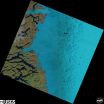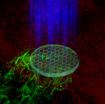(Press-News.org) Predictions of Greenland ice loss and its impact on rising sea levels may have been greatly underestimated, according to scientists at the University of Leeds.
The finding follows a new study, which is published today in Nature Climate Change, in which the future distribution of lakes that form on the ice sheet surface from melted snow and ice - called supraglacial lakes - have been simulated for the first time.
Previously, the impact of supraglacial lakes on Greenland ice loss had been assumed to be small, but the new research has shown that they will migrate farther inland over the next half century, potentially altering the ice sheet flow in dramatic ways.
Dr Amber Leeson from the School of Earth and Environment and a member of the Centre for Polar Observation and Modelling (CPOM) team, who led the study, said: "Supraglacial lakes can increase the speed at which the ice sheet melts and flows, and our research shows that by 2060 the area of Greenland covered by them will double."
Supraglacial lakes are darker than ice, so they absorb more of the Sun's heat, which leads to increased melting. When the lakes reach a critical size, they drain through ice fractures, allowing water to reach the ice sheet base which causes it to slide more quickly into the oceans. These changes can also trigger further melting.
Dr Leeson explained: "When you pour pancake batter into a pan, if it rushes quickly to the edges of the pan, you end up with a thin pancake. It's similar to what happens with ice sheets: the faster it flows, the thinner it will be.
"When the ice sheet is thinner, it is at a slightly lower elevation and at the mercy of warmer air temperatures than it would have been if it were thicker, increasing the size of the melt zone around the edge of the ice sheet."
Until now, supraglacial lakes have formed at low elevations around the coastline of Greenland, in a band that is roughly 100 km wide. At higher elevations, today's climate is just too cold for lakes to form.
In the study, the scientists used observations of the ice sheet from the Environmental Remote Sensing satellites operated by the European Space Agency and estimates of future ice melting drawn from a climate model to drive simulations of how meltwater will flow and pool on the ice surface to form supraglacial lakes.
Since the 1970s, the band in which supraglacial lakes can form on Greenland has crept 56km further inland. From the results of the new study, the researchers predict that, as Arctic temperatures rise, supraglacial lakes will spread much farther inland - up to 110 km by 2060 - doubling the area of Greenland that they cover today.
Dr Leeson said: "The location of these new lakes is important; they will be far enough inland so that water leaking from them will not drain into the oceans as effectively as it does from today's lakes that are near to the coastline and connected to a network of drainage channels."
"In contrast, water draining from lakes farther inland could lubricate the ice more effectively, causing it to speed up."
Ice losses from Greenland had been expected to contribute 22cm to global sea-level rise by 2100. However, the models used to make this projection did not account for changes in the distribution of supraglacial lakes, which Dr Leeson's study reveals will be considerable.
If new lakes trigger further increases in ice melting and flow, then Greenland's future ice losses and its contribution to global sea-level rise have been underestimated.
The Director of CPOM, Professor Andrew Shepherd, who is also from the School of Earth and Environment at the University of Leeds and is a co-author of the study, said: "Because ice losses from Greenland are a key signal of global climate change, it's important that we consider all factors that could affect the rate at which it will lose ice as climate warms.
"Our findings will help to improve the next generation of ice sheet models, so that we can have greater confidence in projections of future sea-level rise. In the meantime, we will continue to monitor changes in the ice sheet losses using satellite measurements."
INFORMATION:
Images / videos
Image download: http://goo.gl/Fuk71X
Caption: Supraglacial lakes on the Greenland ice sheet can be seen as dark blue specks in the centre and to the right of this satellite image.
Credit: USGS/NASA Landsat
Animation download: http://goo.gl/Bg1bno
Credit: Amber Leeson
Further information:
The study was funded by the Natural Environment Research Council (NERC) through their support of the Centre for Polar Observation and Modelling and the National Centre for Earth Observation.
The research paper, Supraglacial lakes on the Greenland ice sheet advance inland under warming climate, is published in Nature Climate Change on 15 December 2014.
Dr Amber Leeson and Professor Andrew Shepherd are available for interview. Please contact the University of Leeds Press Office on 0113 343 4031 or email pressoffice@leeds.ac.uk
For journalists going to the AGU Fall Meeting, please note that Professor Shepherd will also be in attendance, if this helps to facilitate an interview.
Sparks literally fly when a sperm and an egg hit it off. The fertilized mammalian egg releases from its surface billions of zinc atoms in "zinc sparks," one wave after another, a Northwestern University-led interdisciplinary research team has found.
Using cutting-edge technology they developed, the researchers are the first to capture images of these molecular fireworks and pinpoint the origin of the zinc sparks: tiny zinc-rich packages just below the egg's surface.
Zinc fluctuations play a central role in regulating the biochemical processes that ensure a healthy ...
When someone you know is wearing an unfamiliar hat, you might not recognize them. Georgia Institute of Technology researchers are using just such a disguise to sneak biomaterials containing peptide signaling molecules into living animals.
When the disguised peptides are needed to launch biological processes, the researchers shine ultraviolet light onto the molecules through the skin, causing the "hat" structures to come off. That allows cells and other molecules to recognize and interact with the peptides on the surface of the material.
This light-activated triggering ...
BOSTON - December 15, 2014 - In a study published today by Nature, researchers at Joslin Diabetes Center used a microscopic worm (C. elegans) to identify a new path that could lead to drugs to slow aging and the chronic diseases that often accompany it--and might even lead to better cosmetics.
The Joslin team looked at how treatments known to boost longevity in the one-millimeter long C. elegans (including calorie restriction and treatment with the drug rapamycin) affected the expression of genes that produce collagen and other proteins that make up the extra-cellular ...
New research into an Icelandic eruption has shed light on how the Earth's crust forms, according to a paper published today in Nature.
When the Bárðarbunga volcano, which is buried beneath Iceland's Vatnajökull ice cap, reawakened in August 2014, scientists had a rare opportunity to monitor how the magma flowed through cracks in the rock away from the volcano. The molten rock forms vertical sheet-like features known as dykes, which force the surrounding rock apart.
Study co-author Professor Andy Hooper from the Centre for Observation and Modelling ...
The carbon in the atmosphere, ocean, surface life, and other shallow, near surface reservoirs accounts for only about 10% of Earth's carbon. Where is the other 90%? What is it doing? Does it matter?
The Deep Carbon Observatory (DCO), an ambitious 10-year (2009-2019) program of exploration and experimentation, pursues the mysterious 90% while building a new scientific field with a network of scientists from more than 40 countries. Recent results from DCO researchers are filling in the global carbon puzzle with findings that extend our understanding of the origins and limits ...
Researchers at Yale and Boston University and their Russian collaborators have found that occasional heroin use by HIV-positive patients may be particularly harmful to the immune system and worsens HIV disease, compared to persistent or no heroin use.
The findings are published in the journal AIDS and Behavior.
"We expected that HIV-positive patients who abused heroin on an ongoing basis would have the greatest decreases in their CD4 count, but this preliminary study showed that those who abused heroin intermittently had lower CD4 cell counts, indicating a weakened ...
The introduction of neutral umpires in Test cricket led to a drop in the number of LBW decisions going in favour of home teams, a study has revealed.
The findings from research by economists, published by the Journal of the Royal Statistical Society, come amidst renewed debate on whether neutral umpiring is still required in Test matches following the introduction of the Decision Review System (DRS).
Economists Dr Abhinav Sacheti and Professor David Paton from Nottingham University Business School and Dr Ian Gregory-Smith from the University of Sheffield analysed Leg ...
This news release is available in Japanese. New research published in the journal genesis, by Kenneth Baughman, Dr. Eiichi Shoguchi, Professor Noriyuki Satoh of the Marine Genomics Unit at the Okinawa Institute of Science and Technology Graduate University, and collaborators from Australia, reports an intact Hox cluster in the Crown of Thorns starfish, Acanthaster planci. This surprising result contrasts with the relatively disorganized Hox cluster found in sea urchins, which are also echinoderms, classification of animals including starfish, sea lilies, and sea cucumbers. ...
SALT LAKE CITY, Dec. 15, 2014 -- Because of undetected toxicity problems, about a third of prescription drugs approved in the U.S. are withdrawn from the market or require added warning labels limiting their use. An exceptionally sensitive toxicity test invented at the University of Utah could make it possible to uncover more of these dangerous side effects early in pharmaceutical development so that fewer patients are given unsafe drugs.
To prove the point, the U researchers ran their test on Paxil, an antidepressant that thousands of pregnant women used in the years ...
The same species of monkeys located in separate geographic regions use their alarm calls differently to warn of approaching predators, a linguistic analysis by a team of scientists reveals. The study, which appears in the journal Linguistics and Philosophy, reveals that monkey calls have a more sophisticated structure than was commonly thought.
"Our findings show that Campbell's monkeys have a distinction between roots and suffixes, and that their combination allows the monkeys to describe both the nature of a threat and its degree of danger," explains the study's lead ...





